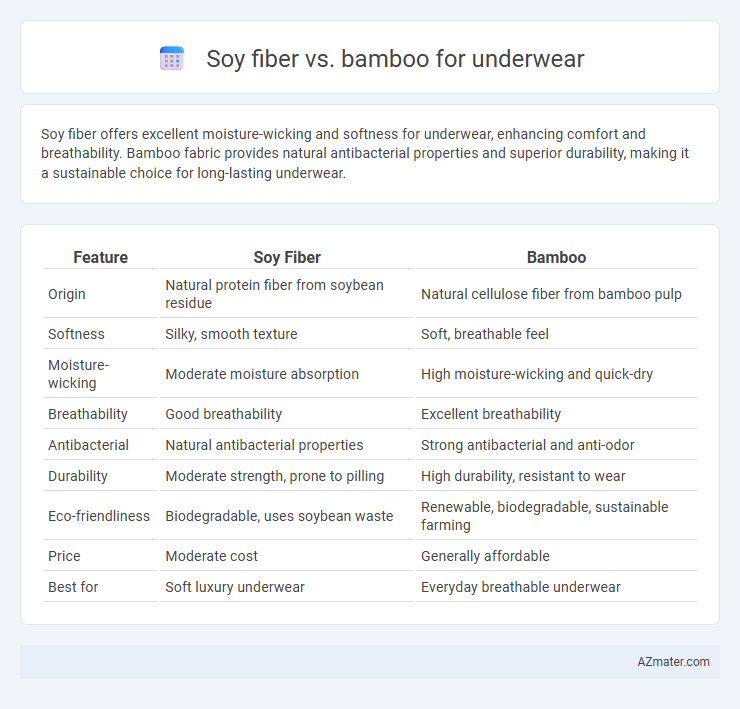Soy fiber offers excellent moisture-wicking and softness for underwear, enhancing comfort and breathability. Bamboo fabric provides natural antibacterial properties and superior durability, making it a sustainable choice for long-lasting underwear.
Table of Comparison
| Feature | Soy Fiber | Bamboo |
|---|---|---|
| Origin | Natural protein fiber from soybean residue | Natural cellulose fiber from bamboo pulp |
| Softness | Silky, smooth texture | Soft, breathable feel |
| Moisture-wicking | Moderate moisture absorption | High moisture-wicking and quick-dry |
| Breathability | Good breathability | Excellent breathability |
| Antibacterial | Natural antibacterial properties | Strong antibacterial and anti-odor |
| Durability | Moderate strength, prone to pilling | High durability, resistant to wear |
| Eco-friendliness | Biodegradable, uses soybean waste | Renewable, biodegradable, sustainable farming |
| Price | Moderate cost | Generally affordable |
| Best for | Soft luxury underwear | Everyday breathable underwear |
Introduction to Sustainable Underwear Fabrics
Soy fiber and bamboo are rapidly gaining popularity in sustainable underwear fabrics due to their eco-friendly properties and comfort. Soy fiber, derived from soybean hulls, offers a silky texture and excellent moisture absorption, while bamboo fabric, made from bamboo pulp, is naturally antimicrobial and highly breathable. Both fibers provide biodegradable, renewable alternatives to conventional synthetic materials, making them ideal choices for environmentally conscious underwear production.
What is Soy Fiber?
Soy fiber is a sustainable fabric made from the byproducts of soybean processing, known for its softness, breathability, and moisture-wicking properties, making it ideal for underwear. It offers natural antibacterial benefits and excellent elasticity, providing comfort and durability in intimate apparel. Compared to bamboo fiber, soy fiber has a smoother texture and is often blended with other materials to enhance fabric strength and maintain environmental friendliness.
What is Bamboo Fiber?
Bamboo fiber is a natural, biodegradable textile derived from the pulp of bamboo grass, known for its softness, breathability, and moisture-wicking properties, making it ideal for underwear fabric. It contains natural antimicrobial agents that reduce odor and promote skin health, enhancing comfort during extended wear. Compared to soy fiber, bamboo fabric offers superior durability and faster moisture absorption, making it a popular eco-friendly choice for sustainable underwear.
Production Process: Soy Fiber vs Bamboo
Soy fiber production involves extracting protein from soybean flakes, which undergoes a chemical process to create a smooth, soft fabric ideal for underwear. Bamboo fiber production starts with harvesting bamboo stalks, followed by mechanical or chemical processing to break down cellulose into fibers suitable for textile use. Soy fiber offers a more sustainable byproduct utilization, while bamboo's production can be resource-intensive, depending on whether the fiber is mechanically processed or chemically regenerated.
Comfort and Breathability Comparison
Soy fiber underwear offers exceptional softness and moisture-wicking properties, making it highly breathable and comfortable for sensitive skin. Bamboo fabric also excels in breathability and has natural antibacterial qualities, providing a cool and odor-resistant experience. Both materials promote airflow and comfort, but bamboo generally has quicker moisture absorption and drying capabilities, enhancing wearability in warm conditions.
Environmental Impact
Soy fiber, derived from leftover soybean protein, offers a sustainable option for underwear production due to its renewable source and biodegradable properties, which reduce landfill waste. Bamboo fabric, known for its rapid growth and low water requirement, supports environmental conservation by minimizing deforestation and pesticide use compared to conventional cotton. Comparing carbon footprints, bamboo generally has a lower impact, but both materials present eco-friendly alternatives to synthetic fibers, promoting biodegradability and resource-efficient textile manufacturing.
Moisture-Wicking and Odor Control
Soy fiber underwear offers excellent moisture-wicking properties due to its natural absorbency, efficiently drawing sweat away from the skin to keep you dry. Bamboo fabric excels in odor control, as its inherent antimicrobial agents reduce bacterial growth, minimizing unpleasant smells during extended wear. Both fibers provide breathable comfort, but bamboo's superior odor resistance makes it ideal for active lifestyles requiring prolonged freshness.
Durability and Care Instructions
Soy fiber underwear offers moderate durability, maintaining softness and shape after several washes, while bamboo fabric excels with high durability due to its natural resilience and moisture-wicking properties. Bamboo underwear requires gentle washing in cold water with mild detergent to preserve fibers, whereas soy fiber benefits from similar care but can be more susceptible to pilling if not handled delicately. Both fabrics demand air drying to extend garment life, but bamboo's inherent anti-bacterial qualities offer an edge in long-term freshness and fabric integrity.
Skin Sensitivity and Hypoallergenic Properties
Soy fiber underwear offers excellent moisture-wicking and softness due to its protein-based fibers, making it ideal for sensitive skin by reducing irritation and allergic reactions. Bamboo fabric is naturally hypoallergenic and antimicrobial, providing superior breathability and moisture management that helps prevent rashes and skin infections. Both fibers excel in skin sensitivity, but bamboo's inherent antibacterial properties give it a slight edge in maintaining skin health for those prone to allergies.
Cost and Availability
Soy fiber underwear typically costs more due to smaller-scale production and limited availability compared to bamboo, which benefits from widespread cultivation and lower manufacturing expenses. Bamboo fabric is more commonly found in mass-market and eco-friendly brands, making it more accessible and budget-friendly for consumers. Both fibers offer sustainable options, but bamboo's higher availability often results in better pricing and easier sourcing.

Infographic: Soy fiber vs Bamboo for Underwear
 azmater.com
azmater.com